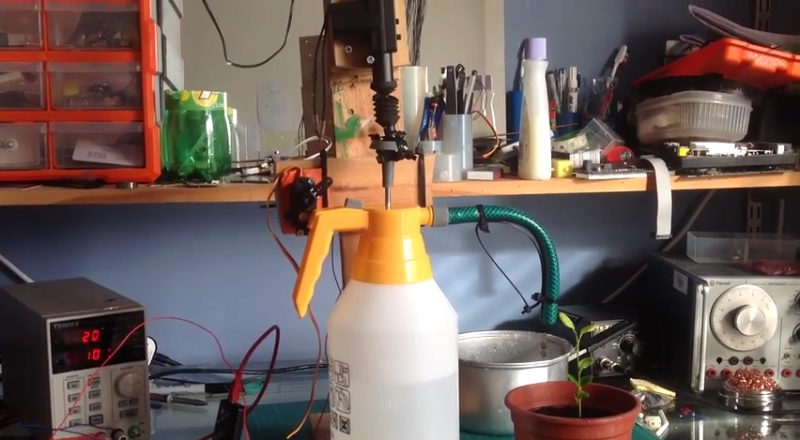[Shane] recently built an automated plant watering system for his home. We’ve seen several similar projects before, but none of them worked quite like this one. Shane’s system is not hooked into the house plumbing and it doesn’t use any off-the-shelf electronic valves.
Instead, [Shane’s] build revolves around a device that looks like it was intended to spray weed killer. The unit works sort of like a Super Soaker. The user fills the jug with water and then pumps a handle multiple times to build up some pressure inside the jug. Then a button can be pressed and the air pressure forces water out of the nozzle. [Shane] came up with a way to automate all of these mechanical motions.
First [Shane] had to find a way to pump up the bottle. He purchased a car door electronic lock actuator from eBay. It’s a pretty simple device. It’s just a DC motor with a gear box that turns the rotational motion of the motor into linear motion. This is mounted to a wooden jig and attached to the pump. A dsPIC microcontroller rotates the motor back and forth, which in turn pumps up the bottle.
The dsPic is also hooked up to a small servo. The servo is mounted to the same wooden jig as the car door actuator. A small arm is mounted to the servo so that when it rotates, the arm presses the pressure release button. This sends the water out of the bottles nozzle. [Pat] hooked up a small length of hose to the nozzle so he can direct the water into his plants. The video below demonstrates how the unit works.















alternatives could be fuel pump…windshield washer pump
That was my thought exactly.. Either use a simple windshield washer pump or add dominoes and a few marbles and go for the whole Rube Goldberg theme.
Or even easier, just use gravity!
certainly not the most elegant solution, but fun! Approve!
That should keep his potatoes well watered.
I know right
You can always use a cheap electric valve (there are latching and non-latching ones that need no water pressure to open for about 10$) and just put the water tank above the level of the plants.
Was all of that really any easier than a peristaltic pump?
Peristatlic pumps wear out comparatively quickly. If this setup goes outside likely faster even with UV stable tubing.
No, peristaltic tube wears out comparatively quickly, the pump lasts nearly indefinitely; either way not on a scale that would be of undue concern in a domestic application. If the tube breaks, cut another length of tube and reinstall. The other benefit is being self priming and positive displacement, if the pump breaks or starts leaking you don’t leak wet shit all over your house.
Either way if you’re using recycled car parts a windscreen washer pump makes a thousand times more sense than this contraption.
Peristaltic pumps suck big time. There are few reasons to ever use one, and this application is definitely not one of them. You also forgot to mention how little actual flow they have or how much they cost.
But yes, a windshield washer pump is a way better choice for this application.
The washer pump wins. One event to deal with, flow rate is fairly constant.
Kiss.
If pump fails no water. If valve fails, water everywhere. Pump gently uphill, no siphon or dumping issues.
I think these would be better than that:
http://www.pollin.de/shop/dt/MjU5OTY2OTk-/Bauelemente_Bauteile/Pumpen/Zahnrad_Wasserpumpe_mit_Motor_RS_360SH.html (german)
ok its an unrelaiable source but eh.
Always plan for failure modes. Because moving parts, especially in water, have short lifespans. The washer pump is probably the safest bet from the failure standpoint. As long as the reservoir is below the outlet it can’t empty itself onto the floor. And 12V/low current is cheap and easy to manage. A line power timer, level sensor and a couple of relays could allow it to empty a small reservoir via the pump once a day. The reservoir could then refill by trickle from a larger volume.
thanks for the information provided help full for me,
It will go for a while until the cheap o-rings wear out ,or the piston shaft cocks to one side.